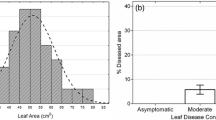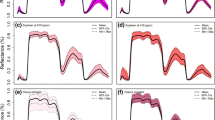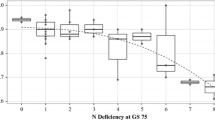Abstract
Spectral characterization of coffee cultivars after pruning may help predict the crop’s diverse phytotechnical behaviors. Therefore, this study aimed to differentiate coffee genotypes based on leaf reflectance following pruning and to develop models capable of estimating the agronomic parameters of vegetative growth. This study included eight coffee cultivars. The biochemical and leaf structure parameters were quantified for the spectral characterization of each genotype and adopted as the basis for the application of vegetation indices and to generate models that can estimate agronomic parameters after pruning. The cultivar Topázio MG-1190 proved to be the most efficient at absorbing electromagnetic radiation in the blue (220–510 nm), green (520–590 nm), and red (690–730 nm) spectral ranges among all other cultivars after pruning. The regression models could estimate the following vegetative growth parameters of the coffee cultivars: height using the normalized difference water index (root mean square error (RMSE) = 5.78%), crown diameter and plagiotropic branch length using the enhanced vegetation index (RMSE = 10.21% and 12.69%, respectively), the number of nodes using the chlorophyll b index (RMSE = 14.47%), chlorophyll a content using the photochemical reflectance index (RMSE = 2.39%), and leaf water potential using the leaf water vegetation index-1 (40.72%). The hyperspectral characterization of coffee cultivars with respect to the phytotechnical development of the genotypes after pruning was successfully accomplished. This tool can assist coffee growers to enhance their competitiveness and productivity through the development of management strategies such as the early detection of plant growth issues.







Similar content being viewed by others
Data Availability
The datasets generated during and/or analyzed during the current study are available from the corresponding author upon reasonable request.
References
Abreu-Júnior, C. A. M., Vinhal, G. P., Xavier, L. C. M., Martins, G. D., & Vieira, B. S. (2020). Mapping nematodes in coffee crop from multispectral images obtained by remotely piloted aircraft. Journal Pathways of Geography, 21, 72–84. https://doi.org/10.14393/RCG217651255.
Ahamed, T., Tian, L., Zhang, Y., & Ting, K. C. (2011). A review of remote sensing methods for biomass feedstock production. Biomass and Bioenergy, 35, 2455–2469. https://doi.org/10.1016/j.biombioe.2011.02.028.
Almeida, T. S., Sediyama, G. C., & Alencar, L. P. (2017). Productivity estimation of irrigated coffee trees by the spectral agroecological zone method. Engineering in Agriculture Journal, 25, 1–11. https://doi.org/10.13083/reveng.v25i1.727.
Assis, G. A., Silva, L. R. S., Martins, W. E. R., Carvalho, F. J., & Pires, P. S. (2018). Growth and productivity of coffee trees in the Alto Paranaíba region as a function of the type of pruning debudding. Agricultural Science, 16, 9–12. https://doi.org/10.28998/rca.v16i2.4467.
Blackburn, G. A. (1998). Quantifying chlorophylls and carotenoids at leaf and canopy scales: An evaluation of some hyperspectral approaches. Remote Sensing of Environment, 66, 273–285. https://doi.org/10.1016/S0034-4257(98)00059-5.
Carvalho, C. H. S. (2008). Cultivars of coffee: Origin, characteristics and recommendations. EMBRAPA CAFÉ, 332 p.
Carvalho, A. M. X., & Mendes, F. Q. (2017). SPEED Stat: a minimalist and intuitive spreadsheet program for classical experimental statistics, in: Annual Meeting of the Brazilian Region of the International Society for Biometrics. Lavras, p. 62.
Chemura, A., Mutanga, O., Odindi, J., & Kutywayo, D. (2018). Mapping spatial variability of foliar nitrogen in coffee (Coffea arabica L.) plantations with multispectral Sentinel-2 MSI data. ISPRS Journal of Photogrammetry and Remote Sensing, 138, 1–11. https://doi.org/10.1016/j.isprsjprs.2018.02.004.
Daughtry, C. S. T., Walthall, C. L., Kim, M. S., Brown de Colstoun, E., & McMurtrey, J. E. (2000). Estimating corn leaf chlorophyll concentration from leaf and canopy reflectance. Remote Sensing of Environment, 74, 229–239. https://doi.org/10.1016/S0034-4257(00)00113-9.
Fazuoli, L. C., Braguini, M. T., Silvarolla, M. B., Gonçalves, W., Mistro, J. C., Gallo, P. B., & Guerreiro-Filho, O. (2018). IAC 125 RN - A dwarf coffee cultivar resistant to leaf rust and root-knot nematode. Crop Breeding and Applied Biotechnology, 18, 237–240. https://doi.org/10.1590/1984-70332018v18n2c35.
Formaggio, A. R., & Sanches, I. D. (2017). Remote sensing in agriculture. São Paulo: Oficina de Textos.
Galvão, L. S., Formaggio, A. R., & Tisot, D. A. (2005). Discrimination of sugarcane varieties with hyperspectral data from the EO-1/Hyperion sensor (pp. 381–388). Goiânia: in: Simpósio Brasileiro de Sensoriamento Remoto.
Galvíncio, J. D. (2017). Relation of leaf water content with real evapotranspiration and biomass in caating biome, using remote sensing data. Brazilian Journal of Physical Geography, 10, 1545–1551. https://doi.org/10.26848/rbgf.v10.5.p1545-1551.
Gamon, J. A., Peñuelas, J., & Field, C. B. (1992). A narrow-waveband spectral index that tracks diurnal changes in photosynthetic effciency. Remote Sensing of Environment, 41, 35–44. https://doi.org/10.1016/0034-4257(92)90059-S.
Gao, B. C. (1996). NDWI-A normalized difference water index for remote sensing of vegetation liquid water from space. Remote Sensing of Environment, 58, 257–266. https://doi.org/10.1016/S0034-4257(96)00067-3.
Gitelson, A., & Solovchenko, A. (2018). Non-invasive quantification of foliar pigments: Possibilities and limitations of reflectance- and absorbance-based approaches. Journal of Photochemistry and Photobiology B: Biology, 178, 537–544. https://doi.org/10.1016/j.jphotobiol.2017.11.023.
Haboudane, D., Miller, J. R., Tremblay, N., Zarco-Tejada, P. J., & Dextraze, L. (2002). Integrated narrow-band vegetation indices for prediction of crop chlorophyll content for application to precision agriculture. Remote Sensing of Environment, 81, 416–426. https://doi.org/10.1016/S0034-4257(02)00018-4.
Hanes, J. M., Liang, L., & Morisette, J. T. (2013). Land surface phenology. In H. Jonathan (Ed.), Biophysical applications of satellite remote sensing (pp. 99–125). Springer.
Hernández-Clemente, R., Hornero, A., Mottus, M., Penuelas, J., González-Dugo, V., Jiménez, J. C., Suárez, L., Alonso, L., & Zarco-Tejada, P. J. (2019). Early diagnosis of vegetation health from high-resolution hyper spectral and thermal imagery: Lessons learned from empirical relationships and radiative transfer modelling. Current forestry Reports, 5, 169–183. https://doi.org/10.1007/s40725-019-00096-1.
Jacquemoud, S. (1993). Inversion of the PROSPECT + SAIL canopy reflectance model from AVIRIS equivalent spectra: Theoretical study. Remote Sensing of Environment, 44, 281–292. https://doi.org/10.1016/0034-4257(93)90022-P.
Japiassú, L. B., Garcia, A. L. A., Guimarães, R. J., Padilha, L., & Carvalho, C. H. S. (2010). Pruning cycles and nitrogen fertilization in coffee crops conducted in the “zero crop” system. Coffee Science, 5, 28–37.
Jiang, J., Comar, A., Burger, P., Bancal, P., Weiss, M., & Baret, F. (2018). Estimation of leaf traits from reflectance measurements: Comparison between methods based on vegetation indices and several versions of the PROSPECT model. Plant Methods, 14, 23. https://doi.org/10.1186/s13007-018-0291-x.
Jiang, Z., Huete, A. R., Didan, K., & Miura, T. (2008). Development of a two-band enhanced vegetation index without a blue band. Remote Sensing of Environment, 112, 3833–3845. https://doi.org/10.1016/j.rse.2008.06.006.
Lichtenthaler, H. K., & Wellburn, A. R. (1983). Determinations of total carotenoids and chlorophylls a and b of leaf extracts in different solvents. Biochemical Society Transactions, 11, 591–592. https://doi.org/10.1042/bst0110591.
Marin, D. B., Alves, M. C., Pozza, E. A., Belan, L. L., & Freitas, M. L. O. (2019). Multispectral radiometric monitoring of bacterial blight of coffee. Precision Agriculture, 20(5), 959–982. https://doi.org/10.1007/s11119-018-09623-9.
Martins, G. D., Galo, M. L. B. T., & Vieira, B. S. (2017). Detecting and mapping root-knot nematode infection in coffee crop u sing remote sensing measurements. IEEE Journal of Selected Topics in Applied Earth Observations and Remote Sensing, 10, 5395–5403.
Ponzoni, F. J., Shimabukuro, Y. E., & Kuplich, T. M. (2012). Remote sensing of Vegetation. São Paulo: Oficina de Textos.
RNC - National Register of Cultivars. Ministry of Agriculture, Livestock and Supply (2022). Retrieved March 1, 2022, from http://sistemas.agricultura.gov.br/snpc/cultivarweb/cultivares_registradas.php.
Rouse, J. W., Hass, R. H., Schell, J. A., & Deering, D. W. (1973). Monitoring vegetation systems in the Great Plains with ERTS, in: ERTS-1 Symposium, Washington, NASA SP-351, pp. 309–317.
Schaepman-Strub, G., Schaepman, M. E., Painter, T. H., Dangel, S., & Martonchik, J. V. (2006). Reflectance quantities in optical remote sensing - definitions and case studies. Remote Sensing of Environment, 103, 27–42. https://doi.org/10.1016/j.rse.2006.03.002.
Schenone, G. R., Nosetto, M. D., & Jobbágy, E. G. (2017). Combined use of thermal and spectral remote sensing to assess coffee plantations’ water use and growth. Remote Sensing, 9(3), 272.
Silva, V. A., Rezende, J. C., Carvalho, A. M., Carvalho, G. R., Rezende, T. T., & Ferreira, A. D. (2016). Recuperação de cultivares de café submetidas ao esqueletamento aos quatro anos e meio de idade. Coffee Science, 11, 55–64.
Tisot, D. A., Formaggio, A. R., Galvão, L. S., & Rennó, C. D. (2005). Hyperion and ETM + data in the classification of agricultural targets with different levels of spectral distinction (pp. 439–446). Goiânia: Simpósio Brasileiro de Sensoriamento Remoto.
Verdin-Filho, A. C., Volpi, P. S., Ferrão, M. A. G., Fonseca, A. F. A., Alixandre, F. T., Comércio, M., & Kaulz, M. (2018). Scheduled cycle pruning in Arabica coffee - PPCA. Paper no. 242, Incaper, Vitória-ES.
Witham, F. H., Blaydes, D. F., & Devlin, R. M. (1971). Experiments in Plant Physiology. New York: D. Van Nostrand Company.
Yudina, L., Sukhova, E., Gromova, E., Nerush, V., Vodenee, V. V., & Sukhov, V. (2020). A light-induced decrease in the photochemical reflectance index (PRI) can be used to estimate the energy-dependent component of non-photochemical quenching under heat stress and soil drought in pea, wheat, and pumpkin. Photosynthesis Research, 146, 175–187. https://doi.org/10.1007/s11120-020-00718-x.
Zhao, B., Duan, A., Ata-Ul-Karim, S. T., Liu, Z., Chen, Z., Gong, Z., Zhang, J., Xiao, J., Liu, Z., Quin, A., & Ning, D. (2018). Exploring new spectral bands and vegetation indices for estimating nitrogen nutrition index of summer maize. European Journal of Agronomy, 93, 113–125.
Author information
Authors and Affiliations
Corresponding author
Ethics declarations
Conflicts of interest/competing interests
The authors declare that they have no conflict of interest.
Additional information
Publisher’s Note
Springer Nature remains neutral with regard to jurisdictional claims in published maps and institutional affiliations.
Electronic supplementary material
Below is the link to the electronic supplementary material.
Rights and permissions
Springer Nature or its licensor (e.g. a society or other partner) holds exclusive rights to this article under a publishing agreement with the author(s) or other rightsholder(s); author self-archiving of the accepted manuscript version of this article is solely governed by the terms of such publishing agreement and applicable law.
About this article
Cite this article
de Menezes Freitas, R.A.S., Martins, G.D., Assis, G.A. et al. Hyperspectral characterization and estimation models for agronomic parameters of coffee cultivars after pruning. Precision Agric 24, 2374–2394 (2023). https://doi.org/10.1007/s11119-023-10044-6
Accepted:
Published:
Issue Date:
DOI: https://doi.org/10.1007/s11119-023-10044-6




